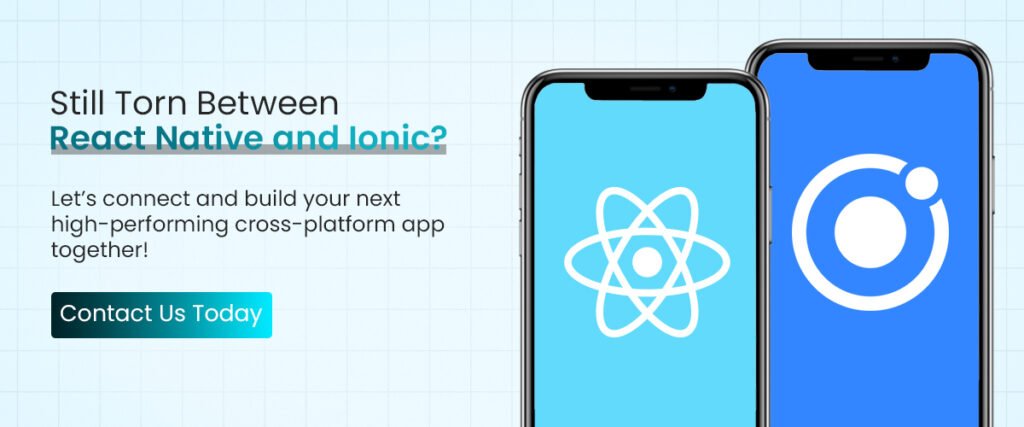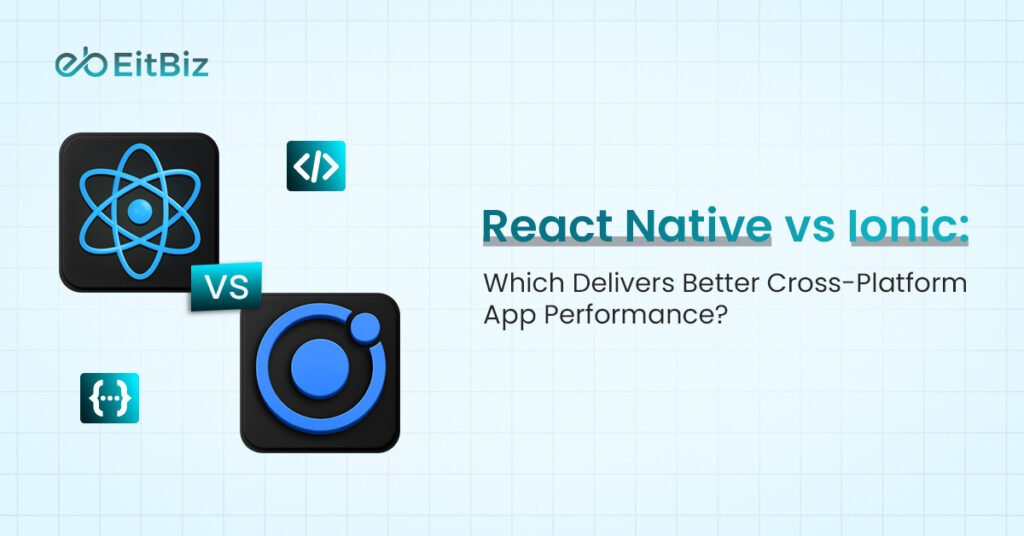You’ve got a brilliant app idea.
You want it to live on both iOS and Android, without building two totally separate codebases. That’s where the real headache begins. Because while “build once, deploy everywhere” sounds ideal, it often comes with a catch: ‘performance’.
Here’s the deal: cross-platform app frameworks are booming. In fact, around 67% of new mobile apps were developed using cross-platform tools in 2025.
And yet, despite that surge, many teams still ask: “Will it feel as fast and smooth as a genuinely native app?”
That’s the exact question when you’re torn between React Native and Ionic. Both promise cross-platform magic, but if your app lags, stutters, or drains battery? Users notice. Downloads drop. Ratings tank.
So, in this article, we’ll cut through the jargon and ask: Which framework actually delivers better performance?
And perhaps more importantly, what trade-offs are you signing up for if you pick one over the other?
Without further ado, let’s dive in!
Overview of React Native
React Native is an open-source framework developed in 2015 by Meta Platforms (formerly Facebook) that lets you build mobile apps for iOS, Android (and even web/desktop) using JavaScript and the React library, but still deliver a native-look and feel.
And here’s a telling stat: over 18,800 companies worldwide use React Native as of 2025.
In simple terms: instead of writing two totally different apps (one for iPhone, one for Android), you write one app in React Native that runs on both, saving time and cost while delivering a near-native experience.
What are the Key Features of React Native?
1. Native Rendering
React Native doesn’t just display your app in a web wrapper. It translates your components into actual native UI elements, so buttons, menus, and animations feel smooth and fast. Users experience a seamless, native-like interface, which improves engagement, load times, and overall app responsiveness.
2. Cross-Platform Development
Write your code once, and it works on both iOS and Android. React Native lets you share most of your logic while giving the flexibility to customize platform-specific features when needed. This reduces development time and costs, allowing teams to launch high-quality apps across multiple platforms without duplicating work.
3. Hot Reloading
Hot reloading lets developers see changes instantly without restarting the app. This speeds up testing and debugging, enabling faster, more efficient iteration. Experimenting with UI tweaks or logic changes becomes hassle-free, enhancing productivity and helping deliver polished apps in shorter timelines.
4. Strong Community & Ecosystem
React Native Development has a massive developer community and a rich ecosystem of libraries, plugins, and tutorials. Facing a problem? Chances are someone has already solved it. This support network helps developers speed up development, reduce bugs, and stay up to date with best practices.
5. Performance That Comes Close to Native Apps
React Native interacts directly with native APIs, giving apps a smooth, responsive, and near-native performance. Unlike frameworks that rely heavily on WebView, React Native apps handle complex animations and heavy data seamlessly, providing users with a faster, more reliable experience.
What Is Ionic?
If React Native feels like a native-first superhero, Ionic is the versatile web-native hybrid champion. Launched in 2013, Ionic lets you build cross-platform apps using familiar web technologies, including HTML, CSS, and JavaScript, so web developers can quickly jump into mobile app development.
Did you know?
As of 2025, Ionic is trusted by over 76,000 companies worldwide.
Instead of converting components into fully native UI elements, Ionic wraps your app in a WebView. Think of it as running a web app inside a native shell. Thus, it may ultimately lead to faster prototyping and easier development, but it can sometimes impact performance compared to truly native frameworks.
What are the Key Features of Ionic?
1. Cross-Platform Development
Ionic lets you write a single codebase that runs on iOS, Android, and even as a web app (PWA). This saves time and resources, allowing developers to deploy faster. You can also tweak platform-specific elements when needed, but most of your logic stays unified across devices.
2. Web Technology-Based
Built with HTML, CSS, and JavaScript, Ionic is perfect for web developers stepping into mobile development. You don’t need to learn platform-specific languages like Swift or Kotlin.
{Also Read: React Native vs. Swift: What to Choose for Your Mobile App?}
This makes app development faster, more accessible, and easier to maintain, especially for teams experienced in web technologies.
3. Pre-Built UI Components
Ionic includes a library of ready-to-use UI components, such as buttons, modals, and sliders. These components are designed to look consistent across platforms, so your app feels polished without spending extra time styling each element for iOS and Android.
4. Access to Native Features
Using Capacitor or Cordova plugins, Ionic apps can access native device features such as the camera, GPS, notifications, and file storage. This bridges the gap between web and native functionality, letting hybrid apps perform tasks usually reserved for fully native apps.
5. Strong Community & Ecosystem
Ionic has an active global community with plenty of tutorials, plugins, and documentation. If you run into a problem, chances are someone has already shared a solution. This makes learning faster and development more reliable, especially for small to mid-sized teams.

Comparison Between React Native & Ionic
Let’s compare both React Native and Ionic based on the following parameters.
| Features | React Native | Ionic |
| Development Language | JavaScript with React | HTML, CSS, JavaScript (Angular, React, Vue) |
| Rendering | Uses native components for near-native performance | Runs in WebView, slightly slower than native |
| Performance | High performance and smooth animations | Moderate performance, may lag on complex apps |
| Cross-Platform | Yes, with optional platform-specific tweaks | Yes, works on iOS, Android, and web (PWA) |
| UI/UX | Native look and feel | Consistent UI, less native-like experience |
| Hot Reloading | Yes, instant code updates | Limited live reload, slower feedback |
| Access to Native Features | Direct native API access | Via Capacitor or Cordova plugins |
| Community & Ecosystem | Large community, extensive libraries | Active community, fewer native plugins |
| Best For | High-performance, complex apps | Rapid prototyping, web-first apps |
| Examples | Instagram, Facebook, Shopify | MarketWatch, Sworkit, Untappd |
Final Thoughts
So, there you have it! That’s a wrap on the React Native vs Ionic in 2025! Both React Native and Ionic are powerful choices for cross-platform app development, but the right one depends on what you value most.
If your goal is performance, speed, and a native-like user experience, React Native is hard to beat. It’s perfect for complex, high-performing apps that demand smooth animations and quick load times.
On the other hand, if you want faster development, cost efficiency, and the ability to use familiar web technologies, Ionic is an excellent pick. It’s ideal for startups or projects where rapid prototyping and broad platform reach matter more than raw performance.
We at EitBiz specialize in building cross-platform mobile apps with React Native and Ionic to optimize performance and deliver stunning, flawless apps that run on all devices. Whether you’re a startup with a bold idea or an established business expanding your digital reach, EitBiz can turn your vision into a high-performing mobile experience that users love.
Ready to bring your app idea to life? Let’s build something extraordinary together. Simply call us at +1.317.463.7064 today!
Frequently Asked Questions
1. Which framework offers better performance: React Native or Ionic?
React Native generally delivers better performance because it uses native components, which make animations smoother and apps more responsive. Ionic, while fast for simple apps, relies on WebView, which can slow down complex apps with heavy data or advanced animations.
2. Which is more cost-effective for app development: React Native or Ionic?
Ionic can be more cost-effective for smaller projects or rapid prototypes because it uses web technologies and a single codebase for multiple platforms. React Native may cost slightly more upfront due to its development complexity, but it pays off in the long run with high-performance, scalable apps.
3. Can I build both iOS and Android apps using React Native and Ionic?
Yes! Both frameworks are designed for cross-platform development. React Native lets you write a single codebase and run it on iOS and Android, while Ionic lets you build apps for iOS, Android, and even the web (PWA), making them versatile choices for reaching multiple platforms.
-

Vikas Dagar is a seasoned expert in the field of web and mobile applications, boasting over 14 years of experience across a multitude of industries, from nimble startups to expensive enterprises.
View all posts
Visit Linkedin




